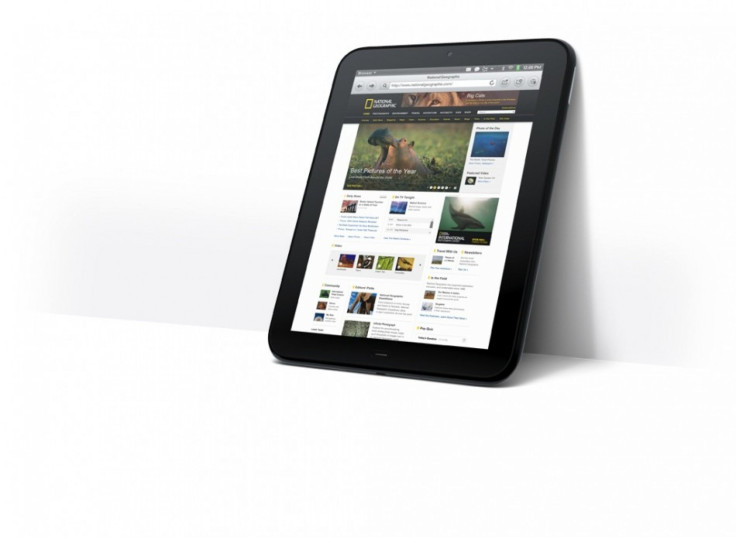HP TouchPad and RIM PlayBook: How They Stack Up

The move is telling: On the heels of its recently released tablet TouchPad, HP replaced its current head of webOS development, Jon Rubinstein, with Stephen DeWitt, the current head of Personal Systems Group (PSG). Rubinstein has been leading the webOS development since HP acquired Palm in 2010.
MUST READ: Netflix Price Increase: Find Newer Movies for Free on Chinese Site
The management reshuffle comes just days after HP's flagship webOS tablet TouchPad hit the shelves. TouchPad was touted to be an iPad 2 killer, and webOS was highly anticipated to become the third platform. However, HP TouchPad has failed to live up to these expectations as the tablet has a clunkier design and has outdated specifications in comparison to iPad 2 and Samsung Galaxy Tab 10.1.
Yet before the webOS-based TouchPad could come, there was another tablet running on a new OS that held the same promise but failed to deliver: RIM's PlayBook.
RIM's PlayBook ushered in a new OS, the QNX. Both HP and RIM share the same story, in that the new OS running their tablets were acquired. HP acquired Palm in April 2010 and got webOS while RIM acquired QNX Software Systems, a maker of real-time operating system, in the same month in 2010. QNX created the Neutrino real-time operating system, software well adopted by the automobile industry to power Bluetooth integration, device connectivity and similar systems.
PlayBook's release in May was dampened when RIM had to recall 1,000 of the newly released PlayBook's due to problems in OS build which resulted in devices being unable to properly load the software during the initial set-up.
HP's hopes of renaissance to become an end-to-end device maker like Apple - which controls the entire cycle of the development of its OS and device - hinges on the success of TouchPad. RIM on the other hand with PlayBook is trying to break free from the corporate tag and is attempting to craft a device ground-up which does not carry the BlackBerry legacy to make it more appealing to app developers.
Here is a comparison between HP TouchPad and RIM PlayBook:
Display:
HP TouchPad followed Apple CEO Steve Job's mantra who believes that 9.7-inch display is the optimum form factor for tablets. Thus TouchPad sports a 9.7-inch screen with 1024x768 screen resolution. RIM on the other hand went after the 7-inch form factor. The PlayBook has a 7-inch display with 1024x600 screen resolution.
Weight and Thickness:
HP TouchPad is bulky weighing 1.65 pounds and is a whooping 0.54-inch thick. In the present scenario where slim is beautiful PlayBook is better positioned as it weighs 0.9 pounds and is 0.4-inch thick. However both the tablets fail to beat Samsung Galaxy Tab 10.1 and iPad 2 when it comes to thinness.
Processor :
RIM PlayBook is powered by a dual-core 1GHz TI OMAP processor. TI OMAP 4430 - the processor that PlayBook uses, NVIDIA Tegra 2 and Samsung Exynos were benchmarked on browser and graphical points by AnandTech for smartphones. LG Optimus 3D's TI OMAP 4 came out trumps with significant improvements, beating the likes of iPhone 4 and Motorola Atrix. The news certainly bodes well for PlayBook. HP TouchPad runs on 1.2GHz dual-core Qualcomm chip. The APQ8060 processor from the QUALCOMM camp is the first to be launched with TouchPad. However TouchPad has been found to be slow as Engadget reported that a boot up required about 1.15 minutes which is eons in comparison to Samsung Galaxy Tab 10.1's dual-core 1GHz NVIDIA Tegra 2 processor which clocks 20 seconds for a cold boot.
Memory:
RIM PlayBook offers 1GB RAM and comes in 8/16/32/64 GB configurations. HP TouchPad also offers 1GB RAM and comes in 16/32GB internal memory configuration.
Camera:
HP TouchPad comes with a single front-facing 1.3 MP camera while RIM PlayBook features a rear-facing 5MP and front-facing 3MP camera. It also offers 1080p video capture capability.
OS:
HP TouchPad runs on webOS 3.0 juice and brings features like stack-based navigation which opens each app as a card. This allows a user the flexibility to merely move the cards to shuffle between various apps or close an app by merely pushing it aside. Similarly RIM PlayBook's QNX OS also offers a different multi-tasking experience as it keeps apps running simultaneously rather than suspending them.
Both HP TouchPad and PlayBook offer excellent compatibility with their respective smartphones Palm Pre 3 and BlackBerry phones. HP TouchPad allows a user to merely bump the tablet to a Palm Pre 3 to transfer URLs, documents and media content to the phone. Similarly RIM PlayBook offers a feature called BlackBerry Syncing which allows the PlayBook to be synced with a BlackBerry phone over the Bluetooth. The sync allows PlayBook to become an extension of BlackBerry phone.
However PlayBook has been derided for not offering native e-mail integration which can only be done through BlackBerry Bridge feature. Sarah Rotman Epps, an analyst with Forrester Research, described the PlayBook as: The PlayBook is a race car that's missing a wheel; the PlayBook is a powerful device with solid hardware, lighter and more compact than the iPad. But by requiring a Bluetooth connection to a BlackBerry phone for basic applications like email, calendar, and IM, RIM has sacrificed consumer-friendliness for CIO peace-of-mind.
Rotman Epps speaking about HP TouchPad said: HP's $1.2B initial investment in Palm, plus its additional investment over the past year to bring the TouchPad and its webOS smartphones to market, is a risky investment -- there's no guarantee that consumers will buy these products or that the consumer electronics market has room for another software platform. But the webOS investment is a risk HP had to take.
Also both the tablets are deficient when it comes to the number apps written for the respective OS in comparison to iPad 2 which boasts 100,000 apps specifically written for the Cupertino tablet.
© Copyright IBTimes 2024. All rights reserved.











